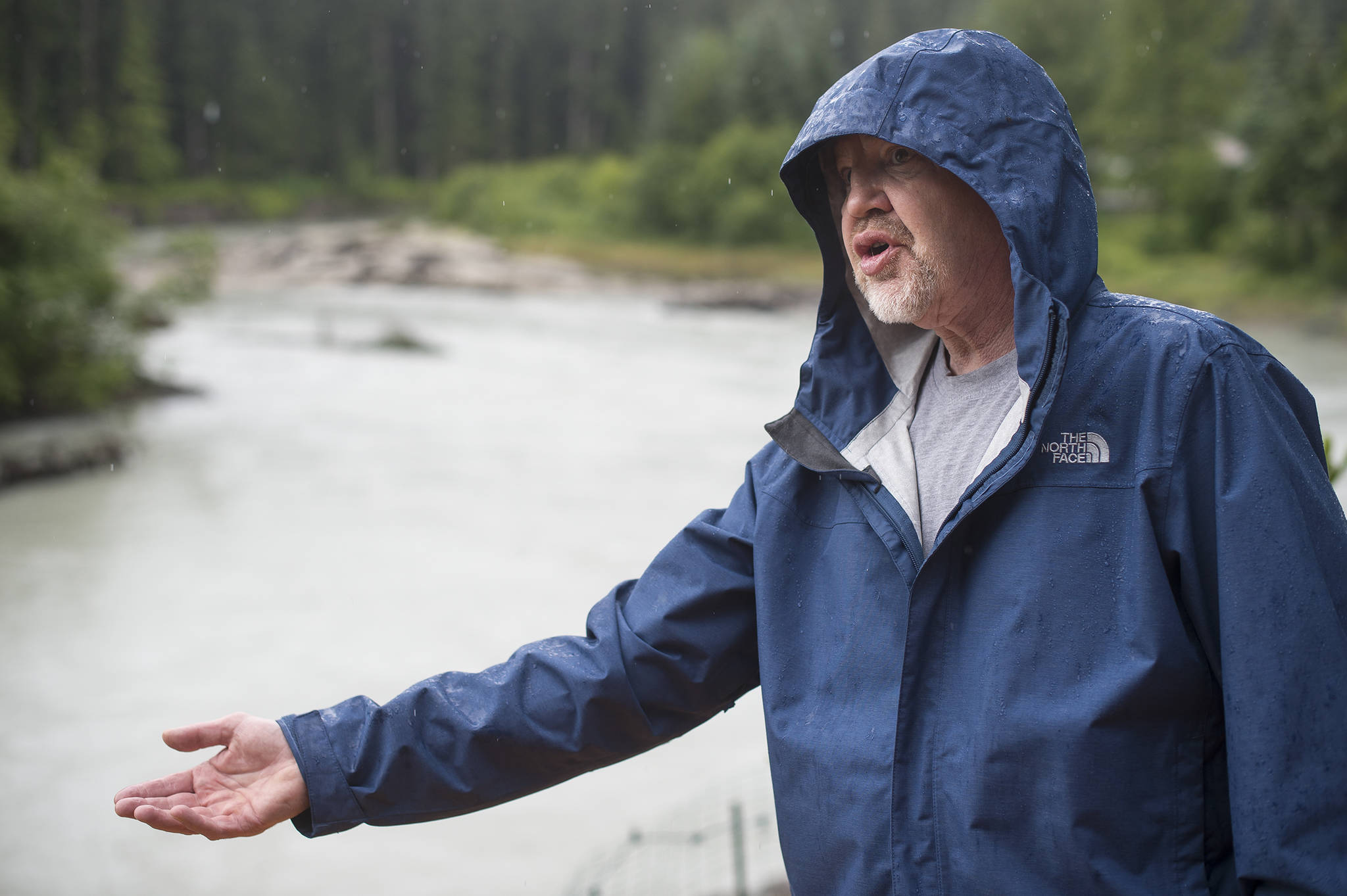Some residents along a stretch of the Mendenhall River are taking the erosion on the river into their own hands.
Multiple neighbors who live on Meander Way in the Mendenhall Valley are working to shore up their riverbanks to save more of their property from falling into the river, neighbor Nico Bus said Thursday. Bus estimated that around eight homeowners are pursuing some kind of solution.
This has been an ongoing problem for years, as neighbors have watched the river claim more and more of their backyards. To stop this erosion, homeowners will have to pay to have contractors install netting and rocks to protect the riverbank. This kind of installation is usually referred to as rip rap.
Bus had rip rap installed on his property a few years ago, and said that as people’s yards are disappearing, they’re becoming more compelled to go through state permitting processes to stabilize their banks. The process involves having an open comment period where the public can weigh in and state officials can review the possible effects of installing rip rap.
“The mood is, we’ve got to get it done,” Bus said. “Whoever feels the urgency is trying to go through the loops. The big question is, what will the estimate be from the contractor to do the work?”
Bus said that when he installed his rip rap, it cost about $25,000. For others, it might cost more.
Norm Staton, whose property has seen the worst effects, is one of the neighbors planning on installing. He’s hoping to get a project started in February along with his neighbor, and said he estimates he’ll have to pay between $40,000 and $50,000. He has been adamant that all of the neighbors should be shoring up their riverbanks as a group effort instead of them all doing it individually at different times.
“I was just hoping that I didn’t have to do this,” Staton said Thursday in reference to having to do a project of his own. “I don’t believe (doing it property by property) is the long-term solution.”
The erosion has sped up in recent years in large part due to glacial flooding known as the jökulhlaup. These floods began in Juneau in 2011, as a large depression in the Mendenhall Glacier known as Suicide Basin filled with rain and meltwater and released the water into Mendenhall Lake and Mendenhall River. It’s happened every year since then, sometimes coming multiple times in a year.
[Authorities, residents brace for annual flooding]
Staton has watched those floods tear his riverbank apart in recent years. He said he was hoping for “the cavalry to arrive,” and thought that help was coming last year.
Throughout 2017 and in the first half of 2018, city officials were working with the Natural Resources Conservation Service (NRCS) to combine federal and city funds with money from the homeowners on Meander Way to commission a project that would have secured the shoreline of 26 homes on the road.
That plan never came to fruition, in part because the neighbors were unhappy with the city making a choice for them and forcing them to pay tens of thousands of dollars. The project was never finalized, but an early plan would have meant each of the 26 households on the stretch of road — regardless of whether they were losing their yards — would have to chip in about $78,000. The scariest part of that proposal for some was that the $78,000 figure was only an estimate, and the project could cost more than originally planned.
In an early survey, 20 of 25 homeowners who responded to a city survey in April 2017 agreed to go through with the plan and pay the $78,000. Members of the City and Borough of Juneau Assembly wanted to get more buy-in from the homeowners and kept working to get more unanimous agreement.
They were never able to get unanimous agreement among the neighbors or among the Assembly members. The Assembly members finally voted down a plan at their May 14 meeting, by a 6-3 margin. By then, the plan had a $5.1 million price tag, including about $3 million from the city and an $80,000 commitment from the residents.
Assembly members Mary Becker, Loren Jones and Jesse Kiehl voted in favor of the project.
“We can’t have a great city if we just allow the river to eat away at (it),” Kiehl said at the meeting.
Kiehl said via text message Thursday that he has been following the neighborhood emails and hopes the neighbors can reach some kind of agreement and work together to solve the problem. City Manager Rorie Watt said via text Friday that the federal program proved “too cumbersome and had too many strings,” and he’s glad the neighbors are taking action.
Staton said he was disappointed. He’s still convinced that the best way to deal with the erosion is to shore up the entire stretch along Meander Way instead of having each portion done differently at different times.
“They didn’t take the lead,” Staton said of the Assembly members. “They left it up to us to take the lead, and that just caused a problem.”
Bus said most neighbors weren’t heartbroken when the plan was voted down in May.
“It’s different reactions because the city and federal government project was to a very high standard, which was making it expensive,” Bus said. “Now, people do it on their own, the feeling is that most people could do it for less than what the city and federal government would charge.”
• Contact reporter Alex McCarthy at 523-2271 or amccarthy@juneauempire.com. Follow him on Twitter at @akmccarthy.

